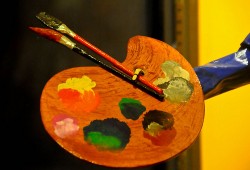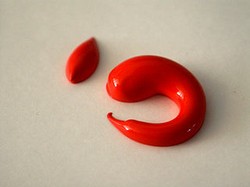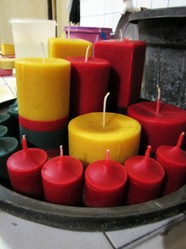Do you want to paint with acrylic? Acrylic paint is a very flexible art medium in painting. Since acrylic is water-based, painting with acrylic paint is less tedious. Acrylic paint lasts a long time too. If you’re still unsure which of the different art media is right for you, acrylic paint is definitely worth a try. Here is a list of art supplies and materials you need to start acrylic painting.

12 Art Supplies and Materials for Painting with Acrylic Paint
Painting with acrylic paint can be very rewarding. Want to paint with acrylic? Here is a list of art supplies and materials you need to start acrylic painting.
Acrylic Paint Set
Of the art materials and supplies you need to start painting with acrylic paint, naturally the first art supply that comes to the list is acrylic paint itself. What is acrylic paint? Acrylic paint is a fast-drying pigment, not as fast as watercolor, but certainly way faster than oil. Unlike oil, the acrylic medium is water-based, making it less difficult to work with. In contrast to watercolor, which is also water-based, acrylic paint is better applied generously in less diluted amount, instead of being mixed with much water as is done with watercolor. Acrylic paint is a flexible art medium, lending itself well to practically any technique in painting, from realist to abstract.
Wondering how many colors of acrylic paint supplies you’d have to buy to start painting with acrylic paints? With just blue, red, yellow and white acrylic paints you can make all hues. Still, buying acrylic supplies in a set of 12 tubes is good. An acrylic paint set of 24 acrylic paints may be better. 36 or more isn’t necessary. Do keep a big tube of white acrylic paint on hand; you’re going to need it along with the next art supplies and materials for painting with acrylic paint.
Art Canvas or Acrylic Paper
Your acrylic painting supplies are incomplete without art canvas or paper. Art canvas is best for acrylic painting. If you do choose paper to work with, it can’t just be any paper; the paper has to be thick enough to absorb and hold the acrylic paint without getting torn. The paper texture is also important. Rough is better, since the rough surface would keep the acrylic paint in place. Acrylic paper, as the name suggests, is best for acrylic painting. Watercolor paper generally works for acrylic painting, too. Pick the watercolor paper that’s thick and rough. Of course you can also choose the art canvas, which is a finer alternative. Just be aware that acrylic paint dries even faster on canvas than on paper; so if you’re painting with acrylic paint on canvas, prepare to either paint faster, or use more acrylic paint.
Acrylic Paint Brushes
Next on our list of art materials and supplies for painting with acrylic paint is the implement you use to apply your acrylic paint on paper or canvas. The paint brushes used in painting with acrylic paint are different from those in painting with watercolor. Watercolor brushes melt upon contact with acrylic paint. You want to use acrylic paint brushes, which is also used with oil. Acrylic brushes come in a number of sizes. You may get all the paint brushes if you like, but you don’t really need to. Just be sure to buy a flat 1, flat 2, then maybe 5 and 12. You could also equip yourself with one acrylic brush that’s as broad as those used to paint houses; this broad brush would hasten spreading the background color over. In the end, the suitable sizes of paint brush depend on your style of strokes — which may require round brushes in addition to flat — and the size of the painting you are making. Bigger brushes are generally more convenient for larger paintings.
Don’t limit yourself to paint brushes though. Who knows, your style of painting might lie in the dishwashing sponge, your toothbrush or other unconventional painting materials. The horizon of possibilities is wide open when it comes to choices of acrylic painting supplies. Even your bare hands can do magic with acrylic paint. Be creative!
Artist Palette
Next on our list of art supplies and materials for painting with acrylic paint is the artist palette. The artist palette, or pallet, is the board or small tray over which you arrange and mix your acrylic paints. Since you won’t be using a lot of water, unlike with watercolor, the artist pallet need not have wells in it and can just be a flat board. The traditional artist palette, the one that curves around a thumbhole with which to hold the palette from underneath, is still the more convenient artist palette to use.
Water or Flow Improver
An almost free yet immensely important item among your acrylic painting supplies is water. Although the art medium becomes water-resistant after drying, acrylic paint is water-based when wet. Hence, as opposed to oil, you can mix acrylic paint with water, instead of turpentine. This makes painting with acrylic paint less costly. If you have more money to spend, however, buy yourself some acrylic flow improver. Flow-improver medium works like water in increasing the fluidity of your acrylic paint, but without diminishing the strength of the color as much. You still need to have some water around though, for three reasons: (1) to wash your brushes before making fresh strokes; (2) to soak the brushes in when not in use, and (3) for cleaning your brushes after completing your acrylic painting.
Water Bucket
Another important component in your art materials and supplies for painting with acrylic paint is a container. You need a vessel to keep your water in. It could be a jar, a glass, or disposable cups. If you want something more suitable for painting with acrylic paint, water bucket designed both for watercolor and acrylic painting makes a good choice. These water buckets have partitions in them to keep separate pools of water, one perhaps for the too muddied and another for the freshly tainted, or one each for washing cool colors, warm colors and black.
Easel
While you can paint on your lap using a canvas frame, that’s not something you want to do all the time. Your art supplies and materials for painting with acrylic paint are incomplete without a surface over which you can work. The ideal device to use is the easel, a stand upon which can place your canvas or paper. It’s comfortable to paint on an easel because the easel keeps the paper or canvas in a relatively vertical position, facing you straight in the eyes, without you having to hunch over it. Of course may use the tabletop, which you probably already have at home. You can’t take the table to go painting outdoors though, so it’s still viable to get an easel, especially if you are that passionate about painting.
Pencil and Eraser
You don’t technically need a pencil and eraser to start painting with acrylic paint; but unless you’re not sketching out your subject before you paint it, pencil and eraser would still be indispensable particulars in your acrylic painting supplies. Pick a pencil with a tip that’s thin and light. You don’t need a pencil that’s thick and dark; you would just be muddling your painting, since the excess graphite mixes with the acrylic paint, unattractively darkening the pigment. All you need is a good enough pencil with which to lay down the composition of your painting and guide your paint strokes accordingly without appearing in the final outcome.
Keep a good eraser on hand, too. Don’t leave mistaken or unnecessary pencil marks on your canvas before you paint it over with acrylic, if that’s not too tedious to do.
Cloth
Whether old clothing or a new towel, have a piece of absorbent cloth in your arsenal of acrylic painting materials and art supplies. When painting with acrylic paint, put the cloth next to your water bucket. After washing your brush in the water, wipe it on the cloth. This keeps water from dripping from your paint brush and making unwanted blotches on your acrylic painting.
Varnish
Of the different art materials and supplies for painting with acrylic paint, I wouldn’t say this is a must-have. Acrylic paintings can generally stand on their own, without need of varnish or framing behind glass. Dust can stick and accumulate over the acrylic painting though. If this bothers you, place your acrylic painting behind glass. Some artists resort to glossing the acrylic painting over with varnish, which enhances the colors of the acrylic painting at the same time, adding a professional touch to the acrylic painting. I personally wouldn’t recommend this though: You might in the future need to remove the varnish, and that would be an extremely tricky business, which could potentially damage your painting.
Toolbox
You can keep your art supplies and materials for painting with acrylic paint in a plastic envelope, straight in the drawer, or better yet, in a separate toolbox. A toolbox helps you organize your acrylic painting supplies, and is handy when painting outdoors, since you can just grab the toolbox and head off to your chosen landscape, your acrylic painting materials intact — except of course for the canvas/paper, water bucket, easel and similar art products, which you’d have to carry separately.
The Subject
Beside all the art materials and supplies for painting with acrylic paint, we cannot leave out the subjects of your acrylic paintings. I wouldn’t know what it is; that would be for you to determine. My advice would be to begin with basic subjects to paint. Maybe start with ceramic jar, then teapot, then organic artifacts. When you’ve had enough of inanimate objects, get some still life: Paint fruits, vegetables and flowers. You can then proceed to painting landscapes, using broader art canvases/papers to work on. Painting people is even more difficult, so you might want to save it for last.
The Acrylic Painting Technique
The most important thing to find in painting is your own, preferably unique style of painting. The value of your acrylic painting is higher when people find it different from others; so having your own native painting technique is invaluable. But that would be something you’d have to discover on your own. Definitely what you need to do is paint, paint, and paint! With practice your art will evolve, you perfect your art, and perhaps inevitably you’d find your very own style of painting. Before you get there, however, you need your own stock of fine art supplies and materials for painting with acrylic paint.
About the Author
Deomar Pandan is a visual artist, online writer and jeweler. He recently launched kamayojewelry.com, and is the artist behind the jewelry items shown in the website.
Photo Credit: Thumbnail photo from Valerie Everett via flickr.com
You might also like
The 11 Different Visual Art MediaThere is an art medium for every artist, the one that he’d love and make mast...
16 Candle-making Supplies and Equipments to Make CandlesCandle-making is a fun craft to do. Do you want to make candles? Get to know ...





















 What Camera to Buy: Compact, Digital SLR or just Phone Camera?on 03/06/2013
What Camera to Buy: Compact, Digital SLR or just Phone Camera?on 03/06/2013
 The 12 Best Scents and Essential Oils from the Philippineson 02/18/2013
The 12 Best Scents and Essential Oils from the Philippineson 02/18/2013
 16 Candle-making Supplies and Equipments to Make Candleson 02/03/2013
16 Candle-making Supplies and Equipments to Make Candleson 02/03/2013
 The 11 Different Visual Art Mediaon 01/22/2013
The 11 Different Visual Art Mediaon 01/22/2013



Do you like painting with acrylic paint?
Pleased to have done so, Hollie. I guess an art software is great, especially for practice — not as messy as the actual art mediums. :)
You've inspired me. I've actually bought a Bamboo with artrage and I'm having the time of my life :)
Hmm, art tutorials? I haven't been painting with acrylic for a long time now; I'm trying a rather unconventional medium. I'll see what I can do.
I don't think you have no artistic skill at all. There must be something in there. It may not be the most realistic style, but at least good enough to produce an art. And the more different, the more original, the better, that's what I think.
Of late, I appear to have regressed to my childhood. I simply can't wait to try out art materials which I have never used and will be really messy. I like the sound of acrylic paints, I think these might the next on my agenda. My dilemma, however, is that I have no artistic skill. I would love to read some art tutorials from yourself, Deomar Pandan! Hint, hint :)